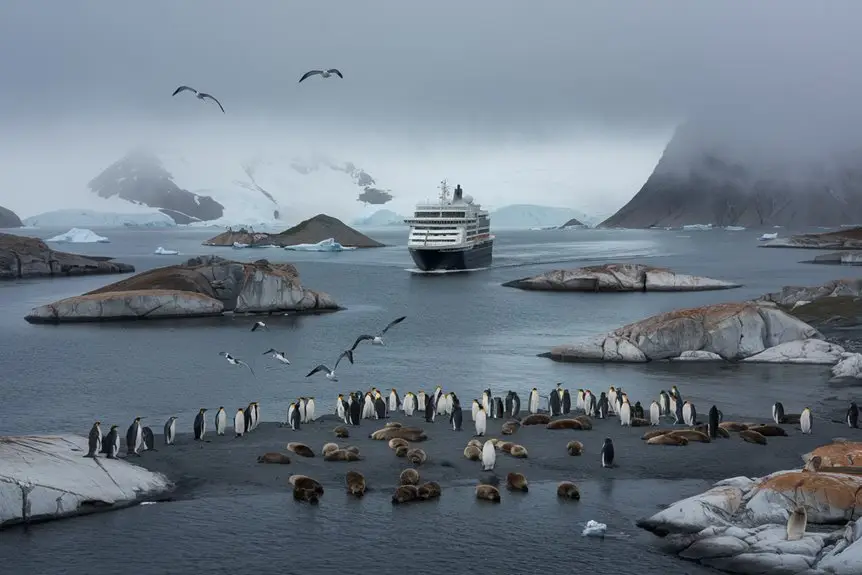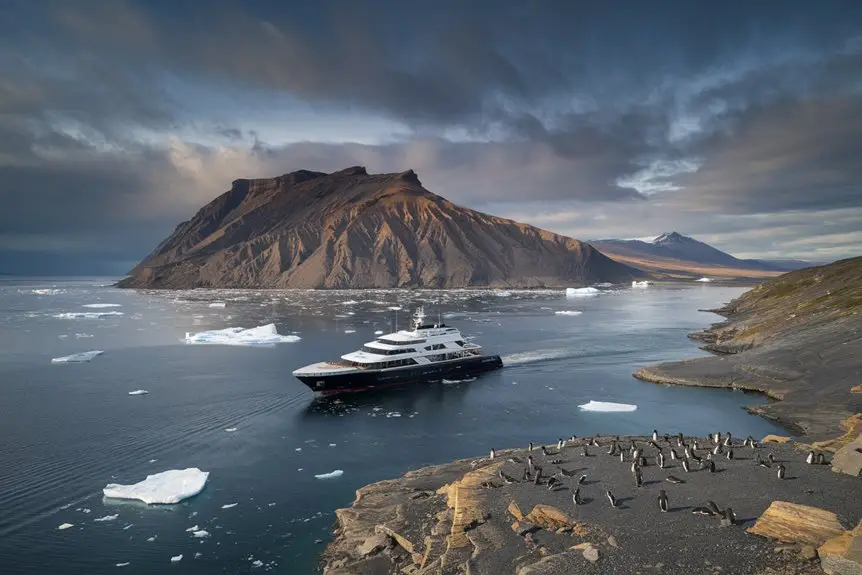Subantarctic Islands cruises depart from three New Zealand ports: Queenstown, Bluff and Dunedin. You can travel between November and March, during the warmest months. Your cruise will take you to remarkable wildlife locations like the Snares Islands, Auckland Islands and Campbell Island. Some routes include Macquarie Island too.
For other Antarctic Cruise destinations check out our Antarctic Cruise Destinations Guide page.
You’ll spend 8 to 28 days at sea on ships designed for polar exploration, such as the Heritage Adventurer or Plancius. These vessels carry Zodiac boats, which you’ll use to reach the islands. Each island offers you close encounters with unique wildlife – you can spot rare penguins and watch vast colonies of albatross. These protected islands showcase pristine nature at its finest.
🐧 Polar Cruise Enquiry 🐻❄️
Our team of polar travel specialists have personally explored both the Arctic and Antarctic regions – from tracking polar bears in Svalbard to kayaking with penguins off the Antarctic Peninsula. Let us find the right polar expedition cruise for you.
Key Takeaways
You can join Subantarctic Island cruises from three New Zealand ports: Queenstown, Bluff or Dunedin. The sailing season runs from November to March.
Your journey will take you through the main circuit of islands:
- The Snares
- Auckland Islands
- Campbell Islands
You can choose trips lasting between 8 and 28 days. For longer adventures, you can combine your Subantarctic voyage with visits to Macquarie Island and the Ross Sea region of Antarctica.
Your ship will be ice-rated and equipped with Zodiac boats, letting you make shore landings and get close to wildlife. Your captain will follow set routes between the islands, taking you to the best spots for:
- Wildlife watching
- Visiting historic sites
- Photography opportunities
The vessels stick to tested sailing paths through the island groups, ensuring you get the most from your Subantarctic experience.
Popular Departure Points

Main Departure Points for Subantarctic Islands
You’ll start your cruise from New Zealand’s southern ports. Queenstown and Bluff stand out as the main departure locations, with operators like Heritage Expeditions and Apex Expeditions using these harbours regularly.
You can reach Bluff through a transfer from either Queenstown or Invercargill.
You can also depart from Dunedin, whilst Half Moon Bay on Stewart Island offers select departures for local water expeditions.
To begin your journey, you’ll need to fly into Invercargill or Queenstown first. Both cities connect well to all cruise departure points.
The cruise season runs from November to March during the southern summer.
Wildlife Viewing Hotspots

You’ll discover incredible wildlife across New Zealand’s Subantarctic Islands, with each island offering unique animal encounters.
The Snares Islands host 5 million birds, making them the region’s busiest wildlife spot. You can spot the unique Snares Crested Penguin here, which lives nowhere else in the world.
The Auckland Islands, the largest group, serve as breeding grounds for two special species: yellow-eyed penguins and Gibson’s wandering albatross.
On Campbell Island, you can watch over 7,000 pairs of southern royal albatross and see striking megaherbs in bloom.
The Bounty and Antipodes Islands let you observe erect-crested penguins and the clever Antipodes parakeet in their natural home.
Each island showcases its own plant life too. You’ll find tree daisies forming dense forests on the Snares, while Campbell Island displays its own special collection of plants.
These untouched islands give wildlife a safe place to thrive, far from human settlements.
Seasonal Sailing Routes

The Subantarctic Islands cruise season runs from November to March during the Southern Hemisphere summer.
You can book trips lasting 8 to 28 days, with ships leaving from New Zealand ports (Queenstown, Bluff, and Dunedin) or Hobart, Australia.
Your route options include:
- New Zealand routes: The Snares, Auckland Islands, and Campbell Island
- Australian routes: Macquarie Island
- Extended routes: Combined Subantarctic Islands and Ross Sea Antarctica visits
- Short routes: Focused visits to specific island groups
You’ll need to pack appropriate clothing for the region’s challenging weather:
- Waterproof outerwear
- Warm layers
- Wind-resistant gear
Expedition Ship Choices

Choosing your Subantarctic Islands ship affects your entire adventure. Several operators offer reliable vessels for these remote waters.
Heritage Adventurer, with its 140-guest capacity and 1A Super ice rating, handles rough seas confidently.
You’ll find Plancius focuses purely on wildlife encounters, whilst Ponant’s ships deliver luxury in these challenging environments.
Small ships from Viva Expeditions give you closer access to wildlife and landing sites. Each vessel carries Zodiac boats for shore landings, and experienced naturalists guide your explorations.
You can visit UNESCO sites and spot diverse wildlife, including penguins and albatross. Your journey will take you to remote spots like the Snares, Macquarie, Campbell and Auckland Islands.
Trip lengths vary from 8 to 28 days, letting you choose the adventure that suits your schedule.
Each operator’s ship maintains high safety standards whilst offering different comfort levels and experiences.
You’ll need to match your chosen vessel with your comfort requirements and exploration goals. Small ships offer intimate experiences, whilst larger vessels provide more amenities.
See what’s on offer from the Antarctic Circle Cruise Journey for a different Antarctic Cruise destination.
Island Hopping Destinations

Subantarctic islands offer you distinct wildlife encounters and unspoilt landscapes.
The Snares Islands showcase multiple albatross species flying above the rugged terrain. You can explore the Auckland Islands‘ beaches and historic huts whilst watching gentoo penguins and elephant seals in their natural habitat.
On Campbell Island, you’ll find unique megaherbs and spot the rare Campbell Island snipe.
Macquarie Island’s main attractions include its royal and king penguin colonies, plus remnants of its whaling past.
Stewart Island brings a different experience with its lush rainforests and potential views of the southern lights.
Each island delivers its own special mix of wildlife and geography, making your journey truly diverse.
Frequently Asked Questions
What Medical Facilities Are Available on Board During Subantarctic Island Cruises?
Subantarctic cruise ships carry qualified doctors and modern medical facilities to care for you. You’ll find a well-equipped treatment room for routine check-ups and emergency care. The onboard medical team stays available 24/7 during your journey. Your ship connects to mainland hospitals through satellite-based telemedicine systems. You can access basic medicines, first-aid supplies, and essential medical equipment right on board. The medical staff can handle common illnesses and stabilise serious conditions until evacuation if needed.
How Strong Are Typical Ocean Swells During These Expeditions?
Ocean swells you’ll face can reach 2-5 metres in normal conditions. During storms, waves can grow to 10 metres or higher. You’ll typically experience regular, rolling swells that build throughout the day. Strong winds often create white-capped waves and choppier conditions. Your ship will encounter both gentle, rhythmic patterns and more challenging seas, depending on weather systems and seasons.
Are Satellite Phones and Internet Connections Available Throughout the Journey?
Satellite connectivity varies during your journey. Your regular mobile phone won’t work, but your ship provides satellite phone and internet services. The connection depends on weather conditions and comes at a premium cost. You can expect occasional access rather than continuous coverage.
What Photography Equipment Is Recommended for Capturing Wildlife in Subantarctic Conditions?
Your essential photography kit for subantarctic wildlife needs:
Primary gear:
- A robust telephoto lens (300mm or longer) for safe wildlife distance
- A 70-200mm lens for versatile shooting
- A 24-70mm wide-angle lens for landscapes
- Two weather-sealed camera bodies for backup
Protection essentials:
- Waterproof camera covers
- Silica gel packs to control moisture
- Insulated gear bag
- Lens cleaning supplies suited for cold conditions
Power management:
- Double your expected battery needs
- Keep batteries warm in inner pockets
- Pack a portable charging solution
Your gear must meet these specs:
- Weather sealing rated to -20°C
- Condensation resistance
- Quick-access features for gloved handling
- Robust build quality for rough conditions
Carry your gear in a water-resistant backpack with padded compartments and easy access whilst wearing heavy clothing.
Can Dietary Restrictions and Food Allergies Be Accommodated on Remote Cruises?
Remote cruises can accommodate your dietary needs and food allergies. You should inform your cruise operator about your requirements when booking. Cruise ships maintain detailed records of passenger dietary restrictions and employ trained kitchen staff to handle special requests. You can expect safe meal options throughout your voyage that match your specific needs. Most ships stock alternative ingredients and maintain separate preparation areas for common allergies. You will receive clear information about available menu options during your cruise.
Thinking about something different? Check out the Antarctic Peninsula Cruise Routes.
🐧 Polar Cruise Enquiry 🐻❄️
Our team of polar travel specialists have personally explored both the Arctic and Antarctic regions – from tracking polar bears in Svalbard to kayaking with penguins off the Antarctic Peninsula. Let us find the right polar expedition cruise for you.
